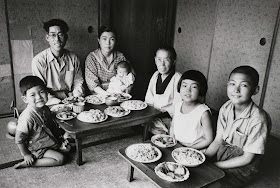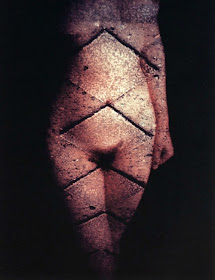In Japan the act of making a photograph consist of capturing the truth, a copy of the very essence of the subject onto a surface. The saying “the camera never lies” would have been true in the early days of photography.
It’s in very few languages where the word for photography and the capturing of this truth is so evident and clear. In Japanese the word for “photograph” is “shashin” (写真), this is made up of the ideograms “sha” and “shin”. The meaning of “sha” is “to reproduce” and “shin” means “truth”, so, in Japan, one is “reproducing the truth”.
 |
| The earliest surviving Japanese photograph of Shimazu Nariakira by Ichiki Shiro |
It is thought that
the first camera in Japan was in 1848 when a Dutch ship brought in a Daguerreotype to Nagasaki (長崎).
The reason that the first camera came
into Nagasaki was that during the Edo government era, import and export was
prohibited except for the permission had been granted Dutch ships to import and
export various goods at the port of Nagasaki. The camera was brought into
Nagasaki by Ueno Toshinojo (上野俊之丞) and then in 1849, was passed to Shimazu Nariakira (島津斉彬). Nariakira later became a feudal lord
of the Satsuma Domain (薩摩藩). It took a further 10 years before the first photograph was taken by
Ichiki Shiro (市来四郎).
Between 1854 and 1858 various treaties were signed with Japan (U.S.A and Britain - , Anglo-Japanese Friendship Treaty, Russia - Treaty of Shimoda), opening the ports of Shimoda, Hakodate and Nagasaki. It is thanks to, what is called in Japan “Kaikoku” (開国) meaning to open the nation to foreign trades, that more cameras and photographic equipment made its way into Japan, along with foreign photographers such as Felix Beato.
A new era of
photography was showing itself in 1862, when photographers (Shishin-shi, 写真師) such as Ueno Hikoma (上野彦馬) and Shimooka Renjo (下岡蓮杖)
opened their studios.
 |
| Samuri by Ueno Hikoma |
 |
| Kowairozukai by Shimooka Renjo 1870 |
 |
| Shimazu Uzuhiko by Uchida Kuichi 1869 |
One of the most famous photographers of this period was Uchida Kuichi. Kuichi became famous because of his portraits of Meiji Emperor (明治天皇) in 1872 and 1873. These photographs, known as Goshin’ei (御真影) were used as public portraits. This was because during the Meiji era very few people, such as prime ministers, could meet Meiji Emperor in person and so most citizens of the Emperor had no chance of seeing Meiji Emperor. The photographic portraits played a huge part in the governing of his Japanese nation.
During 1860 – 1900 a very popular for of photography was Yokohama-shashin (Yokohama Photo, Photographs selling or distributing in Yokohama, 横浜写真).these photographs consisted of Landscapes, culture and Japanese people (especially Japanese women). These, Yokohama-shashin, were used as souvenirs. These souvenir photographs main characteristic were that they were hand coloured.
 |
| Example of Yokohama-shashin |
It was during the
establishment of Meiji Ishin (Meiji
Government), in 1868, that many Japanese people began to travel without the
fear of breaking any laws. The main hotspot for travels, Japanese and foreign,
was Yokohama. Yokohama-shashin began to decline when, towards the end of the 19th
century, picture post cards became far cheaper and became very popular in
Japan. This combined with the rise of the amateur photographer, added to the decline
of Yokohama-shashin.
Around 1880 more amateurs could make
photographs thanks to the introduction of gelatin dry plates, before this it
was the normal to use wet Collodion process. The wet process was a highly
technical and expensive process and so this prevented the amateur photographer
from making photographs.
Kamei Koreaki (1861–1896, 亀井茲明)
and Kajima Seibei (1866–1924, 鹿島清兵衛)
are two of the earliest examples of Japanese amateur photographers. Koreaki
studied in England and Germany, and is known for his photographs of the Sino-Japanese War (日清戦争) in 1895. Seibei took many of his
photographs in the 1890’s, such as a large scale photograph of Mt. Fuji and a
life-size portrait of the actor Manzaburō Umewaka.
 |
| Burying dead enemy by Kamei Koreaki 1894-95 |
 |
| View of Mount Fuji from lake Hakone by Kajima Seibei 1890. |
It was the wide spreading of the gelatine dry plates and the introduction of smaller cameras that gave rise to the
prominent amateur photographers.
So now that I have hopefully helped you
understand a brief history of photography in Japan. Japan is now the home of
many talented and creative photographers so now I shall post a small selection
of Japanese photographers that have caught my eye, whether it is because of
their documentary qualities or the pure creativeness of their works.
Koyo Kageyama ( 影山光洋)
Kageyama is from
Hamamatsu and photographed pre-war and post-World War II scenes of everyday
life in Japan, becoming a freelance photographer after the war.
Hiroshi Hamaya (浜屋宏)
Hamaya is from Tokyo and originally trained
in aerial photography. Hamaya began to
document regional traditions and social issues, primarily on the country's
rugged "back coast" along the Sea of Japan. Later he turned his
attention to Japan’s natural environments.
Kansuke Yamamoto (山本 悍右)
Yamamoto is from Nagoya and is best known
for his poetry and surrealist, avant-garde photography. He found his inspiration
through the surrealist art of Europe, producing highly innovative works of photography
and poetry.
Mika Ninagawa (蜷川実花)
Ninagawa
is from Tokyo, known for her flowers, goldfish and landscapes that burst with
vibrant colour. She made a success via the world of advertising and fashion. Her work is highly
acclaimed across the generations from teen fashion magazines to high-end
commercial fashion and advertising.
Nobuyoshi Araki (荒木 経惟)
Araki
is from Tokyo and is best known by his nickname Arākī (アラーキー). His
first published book, “Sentimental Journey”, was that of his wife, Yōko Araki (荒木陽子),
after they were married during their honeymoon. He is known as one of the most
prolific artists in Japan, having publishing over 350 books by 2005 and still
producing more as each year goes on. Araki’s photographs are erotic and, more
often than not, considered pornographic.
Among some of the people he has photographed is the Icelandic musician
Bjork for her 1997 remix album, and the pop singer Lady Gaga.
Written by Paul Casey Hemming
@ Big World Picture Dot Com
ポール·ケーシーヘミングによって書か
@ビッグワールドピクチャードットコム
Please feel free to add any thoughts or comments below.
Hover your pointer over left contents column then use your scroll wheel or button to view more posts.
ポール·ケーシーヘミングによって書か
@ビッグワールドピクチャードットコム
Please feel free to add any thoughts or comments below.
Hover your pointer over left contents column then use your scroll wheel or button to view more posts.



















.jpeg)



No comments:
Post a Comment
Comments, feedback and questions.